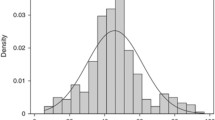Abstract
In this paper I apply the work of Abrams and Iossifov (Public Choice 129:249–262, 2006) to monetary policy in Canada to see if same political party affiliation is needed to produce evidence of political opportunism. After modifying their analysis to maintain the time-series consistency of their variables for Canada, I find that both an error correction model and a Taylor rule reformulation of their test generate evidence consistent with same party political opportunism, but only weakly so. On the other hand, I also find the presence of more traditional indicators of political influence. In particular, the data suggest that the election of a Liberal party government, a decrease in the degree of political competition, and to a lesser extent, the election of a minority government all positively influence the expansiveness of Canadian monetary policy.
Similar content being viewed by others
References
Abrams, B. A. (2006). How Richard Nixon pressured Arthur Burns: Evidence from the Nixon tapes. Journal of Economic Perspectives, 20, 177–188.
Abrams, B. A., & Iossifov, P. (2006). Does the Fed contribute to a political business cycle? Public Choice, 129, 249–262.
Alesina, A., & Summers, L. H. (1993). Central Bank independence and macroeconomic performance. Journal of Money, Credit and Banking, 25, 151–162.
Alesina, A., Roubini, N., & Cohen, G. D. (1997). Political business cycles and the macroeconomy. Cambridge: MIT Press.
Allen, S. D., & McCrickard, D. L. (1991). The influence of elections on federal reserve behavior. Economic Letters, 37, 51–55.
Beck, M. J. (1968). Pendulum of power. Scarborough: Prentice Hall Canada.
Beck, N. (1987). Elections and the Fed: Is there a political business cycle? American Journal of Political Science, 31, 194–216.
Belongia, M. T. (2007). Opaque rather than transparent: Why the public cannot monitor monetary policy. Public Choice, 133, 259–267.
Crow, J. (1993). Institutional arrangements and policy objectives of Central Banks: A Canadian perspective. The Gerhard de Knock memorial lecture at the University of Pretoria. Ottawa: Bank of Canada.
Ferris, J. S., & Winer, S. L. (2007). Politics, political competition, and the political budget cycle in Canada, 1870–2000: a search across alternative fiscal transmission mechanisms. Carleton Economic Papers, 06-05, 1–43.
Ferris, J. S., Park, S. B., & Winer, S. L. (2007). Studying the role of political competition in the evolution of government size over long horizons. Retrieved September 15, 2007 from Carleton University website: http://http-server.carleton.ca/~winers/papers/Political_Competition_Jan_9_2007.pdf.
Filer, J. E., & Kenny, L. W. (1980). Voter turnout and the benefits of voting. Public Choice, 35, 575–585.
Hibbs, D. (1977). Political parties and macroeconomic policy. American Political Science Review, 71, 1467–1487.
Kontopolous, Y., & Perotti, R. (1999). Government fragmentation and fiscal policy outcomes: Evidence from OECD countries. In J. Poterba, J. von Hagen (Eds.), Fiscal institutions and fiscal performance (pp. 81–102). Chicago: University of Chicago Press.
Laney, L. O., & Willett, T. D. (1983). Presidential politics, budget deficits, and monetary policy in the United States: 1960–1976. Public Choice, 40, 53–69.
Leertouwer, E., & Maier, P. (2001). Who creates political business cycles: Should central banks be blamed? European Journal of Political Economy, 17, 445–463.
Persson, T., Roland, G., & Tabellini, G. (2004). How do electoral rules shape party structures, government coalitions, and economic policies (CESifo Working Paper No. 1115).
MacKinnon, J. G. (1996). Numerical distribution functions for unit root and cointegration tests. Journal of Applied Econometrics, 11, 601–618.
Nordhaus, W. (1975). The political business cycle. Review of Economic Studies, 42, 169–190.
Saikkonen, P. (1991). Asymptotically efficient estimation of cointegration regressions. Econometric Theory, 7, 1–21.
Siklos, P. L. (2002). The changing face of central banking. Cambridge: Cambridge University Press.
Solé-Ollé, A. (2006). The effects of party competition on budget outcomes: Empirical evidence from local governments in Spain. Public Choice, 126, 145–176.
Templeman, J. H. (2007). A commentary on “Does the Fed contribute to a political business cycle”? Public Choice, 132, 433–436.
Thiessen, G. (2000). Can a bank change: The evolution of monetary policy at the bank of Canada 1935–2000. Lecture by the Governor of the Bank of Canada to the Faculty of Social Science at the University of Western Ontario, October 17, from the Bank of Canada web site: www.bank-banque-canada.ca/en/publication/speeches/2000.
Woodford, M. (2003). Interest and prices: Foundations of a theory of monetary policy. Princeton: Princeton University Press.
Author information
Authors and Affiliations
Corresponding author
Additional information
I would like to thank Patrick Coe, Chuck Freedman, Pierre Siklos, Marcel Voia, and Stan Winer for comments made on earlier versions and particularly both Soo-Bin Park, who led me out of a problem with lags, and the editor and a referee from this Journal, who emphasized the presence of apolitical cyclical influences. None are responsible for remaining errors of omission or commission.
Rights and permissions
About this article
Cite this article
Ferris, J.S. Electoral politics and monetary policy: does the Bank of Canada contribute to a political business cycle?. Public Choice 135, 449–468 (2008). https://doi.org/10.1007/s11127-007-9272-8
Received:
Accepted:
Published:
Issue Date:
DOI: https://doi.org/10.1007/s11127-007-9272-8




